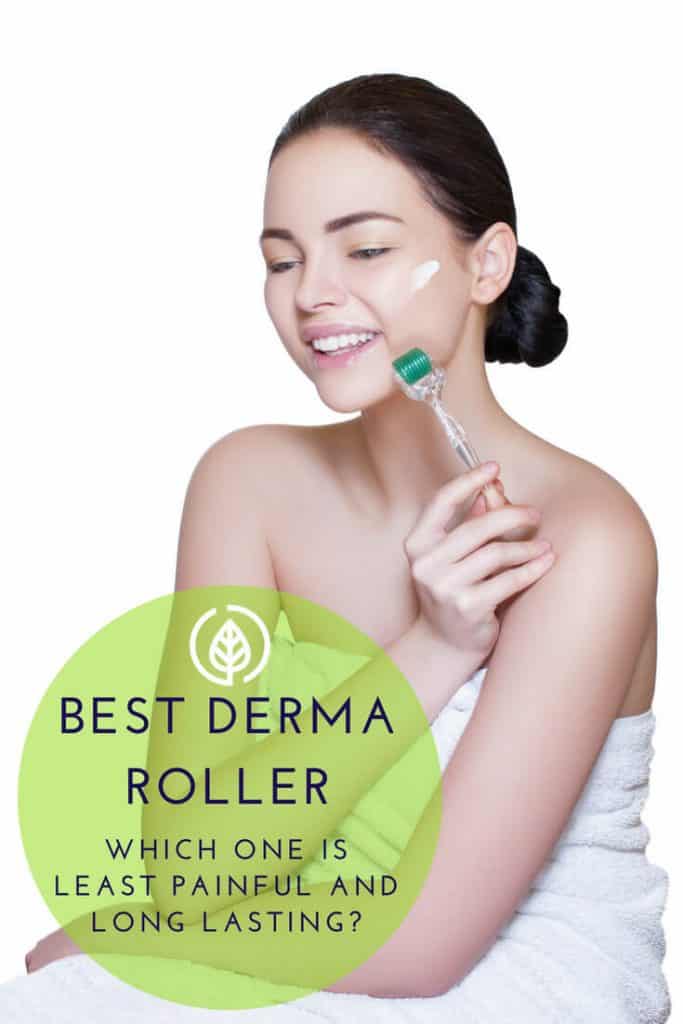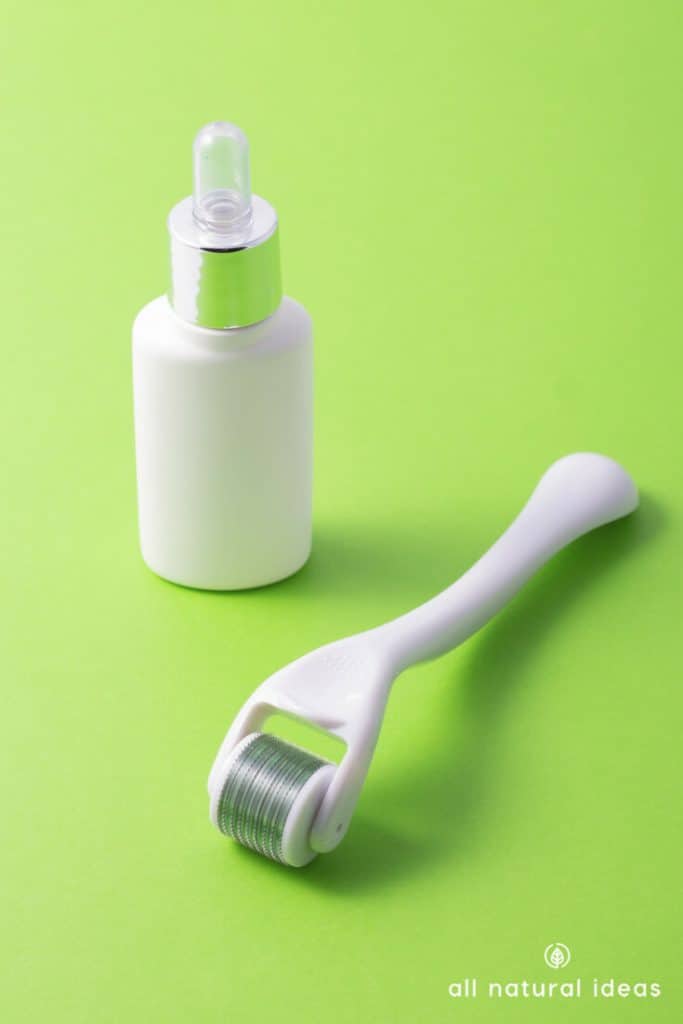If you want better skin, are you willing to prick your face with dozens of needles? Though it sounds medieval, treating acne, wrinkles and stretch marks by using the best derma roller is relatively painless.

Don’t worry. For better looking skin, you don’t need to have a painful treatment of pins.
However, if you do want less visible acne scars, wrinkles or stretch marks, you just might want a face full of needles.
Microneedles, that is.
Microneedling, or derma rolling, has been around for about 20 years. Back when the procedure first became available, it was mostly done under the care of an aesthetician.
But these days, it’s possible to microneedle at home.
However, not all rollers are the same. There’s of course the quality issue.
Moreover, some skin problems require longer needles while others require shorter ones. And that’s not all.
You also need to know what you should and shouldn’t apply to your skin before and after doing a derma roller session. And that brings to mind one other factor: how many times it will take for microneedling to show positive results.
So keep reading for some of the skinny on skin care with the best derma rollers….
What is a derma roller and how much do they cost?
Rollers vary in price, costing anywhere from under a dollar to several hundred. And because you may have to change the device from time to time, a set of high-quality rollers can cost thousands of dollars.
If you’ve never done microneedling before, you can learn how to do it by spending lots of time researching and watching videos. Or, you can book an appointment with an aesthetician.
Without doubt, doing it at home will save you money. But perhaps it’s best if you do the initial session with a professional.
An aesthetician can best tell you what type of device (or devices) to buy. A beautician or other professional can also suggest how often you should microneedle.
Furthermore, an aesthetician can also recommend serums to enhance the procedure’s benefits (more on this below).
If you’ve only heard of derma rolling and have no clue what it is, here’s a brief explanation:
Picture a lint roller. Now add hundreds of miniscule needles to it.
Now, roll that lint roller over your skin. Sounds painful, right? Well, if you want to be more attractive, you’ll do whatever it takes perhaps?
The good news is that when you use the best derma roller, there’s no pain.

Derma Rolling: like weightlifting for your skin?
Unlike the weightlifting mantra, “no pain, no gain,” microneedling registers less than a blip on the discomfort scale. Sort of like going for an acupuncture session; you hardly feel it.
But here’s what it does have in common with weightlifting.
When you lift heavy weights, the reason why your muscles get stronger and leaner is because of microtears.
While you’re sleeping, your muscles undergo repair. And with adequate rest and nutrition (protein), your musculature improves.
It’s the same with derma rolling.
You see, underneath what you can see as your visible skin is collagen.
Collagen is the most abundant protein in the human body. Essentially, it’s like a glue for your cells.
But your collagen starts breaking down at the rate of at least one percent every year after age 30 or so. Poor diet, inadequate sleep, stress and just getting older are the primary collagen killers.
Imagine a skyscraper. Picture the erect steel girders that are the foundation of the skyscraper.
This is what the structure of collagen fibers in your body looks like in your early 20s.
But when you’re a couple decades or more older, your collagen doesn’t look the same.
In fact, instead of an erect supportive structure, it looks more like a sad, saggy circus tent that’s been blown to bits by a hurricane.
How does it work?
Here’s where the best derma roller comes to the rescue. Microneedling creates mini injuries to the skin.
This helps your body regenerate collagen.
According to The Journal of Cutaneous and Aesthetic Surgery, microneedling leads to the release of growth factors.
These growth factors stimulate the formation of new collagen and elastin.
Elastin is another major protein in connective tissue. In addition, microneedling forms new capillaries.
And it’s the formation of these new blood vessels and collagen protein that leads to the reduction of scars.
If you have acne scars, the Journal says the standard roller contains 192 microneedles in eight rows. The needles should measure 0.5-1.5 mm in length and 0.1 mm in diameter.
When you microneedle yourself (or have someone do it for you), the needles pierce your skin. Tiny holes are created without actually doing long-term damage.
Research shows that microneedling over an area for 15 times will result in approximately 250 holes per centimeter squared. That’s a lot of tiny holes!
If you’re curious about how the rollers are made, it’s by a reactive ion etching technique on silicon or medical-grade stainless steel.
Like tattoo needles, they are sterilized. As opposed to derma rollers at home, the medical-grade ones are for single use only.
How Long Does It Take?
It depends. If you’re getting it done professionally, first, you might get topical anesthesia. The procedure might take 45 minutes to one hour.
The professional will roll your skin up to 20 times in each direction (up, down, horizontal, sideways).
Rolling may cause pin-point bleeding. If you’re doing it at home and your skin bleeds, simply use a saline pad to treat the punctures.
The Journal says that a minimum of six weeks is recommended between two treatments as it takes that long for new natural collagen to form. “Three to four treatments may be needed for moderate acne scars.”
Are there side effects?
Even if you’re using the best derma roller on the planet, it’s possible you may experience superficial reddening of the skin. It usually is visible in patches.
However, a healing essential oil or topical cream can solve the problem. Other than that there’s no serious negative effect of microneedling.
Can you do derma rolling with other treatment?
Yes. The author of the above-mentioned research study says that it can be combined with other acne scar treatments like subcision, chemical peels, microdermabrasion, and fractional resurfacing.
And doing a combination of these therapies actually maximizes the benefits.

Home Rolling
This dermatology journal from India says that if you use a roller at home, they can be used twice a week for up to 100 times.
After each use, you should clean it in hot tap water, the article suggests.
Also, if you have, let’s say a small scar under your eye, you can buy a mini-roller. This is called a dermastamp. And it only takes a couple of minutes to use one on a particular area.
When buying the best derma roller, keep these important things in mind:
First, is quality. If you see a roller listed for $1 on eBay, chances are it’s not top of the line. Buying a low quality roller may result in the needles breaking off in your skin!
Second, don’t expect miracles. With multiple sessions, you will likely notice positive results such as diminished scarring.
However, one session won’t totally eliminate acne scars.
Third, have faith. It works.
According to this study, 480 patients with wrinkles, saggy skin, scarring and stretch marks had derma rolling. The researchers claim that the subjects all ended up with tighter, smoother skin.
Moreover, some of the patients received only one treatment. Imagine if they would have received more.
The maximum number of treatments in the study: just four. In addition to the microneedling procedure, the patients were prepared with topical vitamin A and C cosmetic creams.
The creams were given for at least a month before the procedure.
On average, a certain layer of skin in the patients thickened by 40 percent.
The researchers also write that microneedling is good for regions where laser treatments and deep peels cannot be performed.
Best derma roller for acne scars
Got acne scars?
First rule of thumb, don’t scratch or pick at the scars.
Second rule: don’t use a roller as an acne treatment. If you have pimple breakouts, wait until the pimples clear.
However, if you do have acne scarring, microneedling can help.
Here’s what a source at SkinHelpers.com recommends….
The Titanium Microneedle Derma Roller, 0.25 mm by Derma Lite is best for minimizing scars. Without doubt there are other top-quality ones.
However, the source at SkinHelpers likes this particular roller because of its popularity among dermatologists. The reviewer adds that the product is compatible with all skin types including sensitive skin.
Furthermore, you can use it every few days on the face or neck before applying your usual skincare creams.
The only bummer about this product is the roller head needs replacing fairly regularly—approximately every 8 uses.
Best derma roller for stretch marks
Needles for stretch marks need to be larger. Choose a roller with 1.0mm needles.
(For wrinkles and aging, 0.5mm at home is good; 0.25 is good when you want to use another topical product, and 0.75 is for moderate scars.)
It’s best not to use an at-home roller with needles 1.5mm in size or larger.
Best serum to use with derma roller
According to this British microneedling source, only a relatively small percentage of the active ingredients in cosmetics can penetrate the skin.
Well over 90% of the ingredients supposedly does very little if anything.
However, using a derma roller boosts the absorption deep into the skin significantly.
For this reason, it’s best to use a serum that will help not only make your skin look radiant, but also aid in the repair process.
The best serum to use depends on what your goal is. If it’s for sensitive skin, the British reviewer says that It’s Skin Redness Reducing Power 10 Serum works best.
And if your skin is oily and has lots of blemishes, use The Ordinary Niacinamide 10% + Zinc 1%.
For wrinkles and other aging fine lines, try Kate Somerville Wrinkle Warrior.
Those with dryness might want to give Josie Maran Pure Argan Milk Intensive Hydrating Treatment serum a shot.
And finally, for those with hyperpigmentation Sunday Riley C.E.O. Rapid Flash Brightening Serum may work wonders.
But do your own research and read some of the other roller reviews before you buy.
And one last piece of advice about the best derma roller for your particular skin problem: don’t wear makeup or sunscreen after pricking your face with a derma roller. The treatment opens up the pores and makes other stuff you apply to your skin absorb deep.





